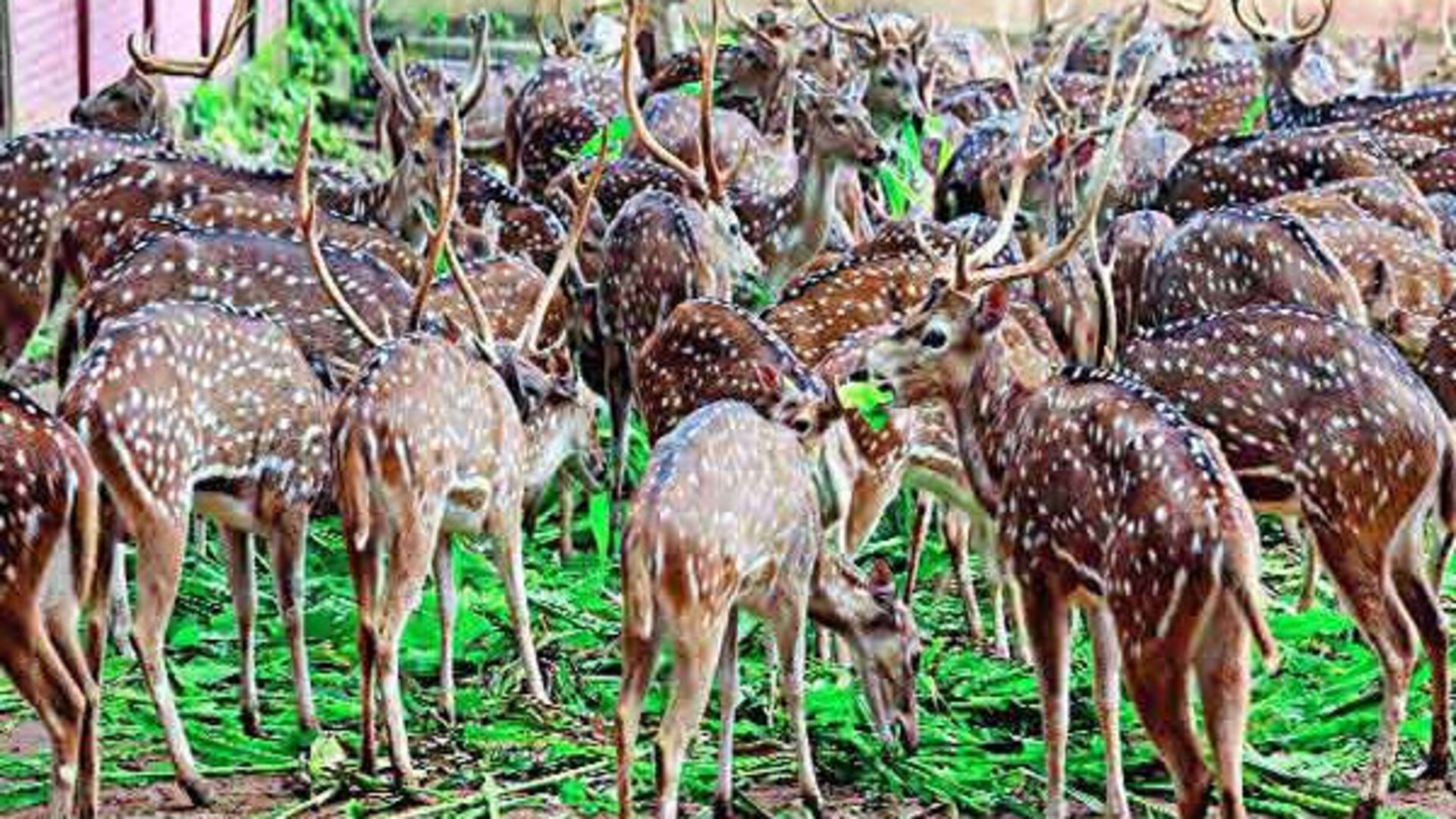Gazipur Safari Park, located in the district of Gazipur, just outside of Dhaka, Bangladesh, has taken a significant step in expanding its wildlife offerings by acquiring 50 new Chitra deer, also known as spotted deer or Axis deer (Axis axis). This monumental expansion is part of a larger initiative to enhance the park’s biodiversity, increase educational opportunities, and elevate its status as one of the foremost wildlife conservation destinations in Bangladesh.
The inclusion of these new animals is expected to not only enrich the park’s ecosystem but also draw more visitors from both home and abroad, eager to witness the beauty of these gentle creatures. The decision reflects Gazipur Safari Park’s ongoing efforts to promote wildlife conservation, ecotourism, and environmental awareness while fostering sustainable tourism practices.
The Chitra deer is an iconic species found primarily in South Asia, particularly in India, Nepal, and Bangladesh. Known for their striking appearance, these deer have a reddish-brown coat speckled with white spots that make them stand out in forested environments. Their graceful presence has long been admired by nature lovers, and their role in maintaining forest ecosystems is crucial.
The deer are highly social creatures, often seen in large herds that consist of females and their young, while males usually stay solitary or in small groups. Their diet primarily consists of grasses, fruits, and leaves, and they are frequently seen grazing in forest clearings. In Bangladesh, the deer are symbolic of the rich wildlife diversity found within the country and represent a species that must be protected due to various environmental threats.
Historically, Chitra deer populations have faced declines due to habitat loss, poaching, and deforestation. As human activities continue to encroach on their natural habitats, conservation efforts have become crucial in safeguarding their existence. Wildlife parks such as the Gazipur Safari Park play a pivotal role in these conservation efforts by providing a secure environment for these deer to thrive, free from the dangers they face in the wild.
Expansion Strategy and Conservation Vision:
The introduction of 50 new Chitra deer is part of Gazipur Safari Park’s broader strategy to reinforce its role as a hub for wildlife conservation and education. This latest acquisition aligns with the park’s long-term vision of developing an ecosystem that not only protects endangered species but also educates the public on the importance of conserving the natural world.
Gazipur Safari Park, since its establishment, has prioritized the protection of native species and the creation of a balanced ecosystem where animals can coexist in a naturalistic environment. The park is home to a wide array of species, ranging from Bengal tigers, lions, and elephants, to smaller, lesser-known animals that are crucial for maintaining ecological equilibrium. The addition of Chitra deer adds to this diversity and helps establish a more comprehensive representation of Bangladesh’s wildlife.
In bringing in these deer, the park is not only enhancing its biodiversity but also contributing to the global conversation on species conservation. By offering a sanctuary for these animals, Gazipur Safari Park demonstrates its commitment to wildlife preservation, especially at a time when habitat loss and environmental degradation threaten many species.
Creating an Ideal Habitat for the Chitra Deer:
To ensure the successful integration of the new deer, park authorities have worked meticulously to create an environment that closely mimics the deer’s natural habitat. The area designated for the Chitra deer spans across lush, grassy plains and wooded sections of the park, providing ample space for them to roam, graze, and interact with other herbivores.
Maintaining the right balance between open grassland and forested areas is essential for the well-being of these animals. The Chitra deer need large expanses of land for grazing, while the cover of trees provides them with a sense of security from potential predators. The park’s landscape design ensures that the deer can lead lives similar to what they would experience in the wild, encouraging natural behaviors like foraging, herd formation, and seasonal mating rituals.
Additionally, the park’s veterinary team has developed a rigorous health-monitoring program to ensure that the deer are well-cared for. This includes regular check-ups, vaccinations, and dietary adjustments as needed. By closely monitoring the health and behavior of the Chitra deer, the park aims to keep the population thriving and stable.
Boosting Ecotourism and Visitor Engagement:
Gazipur Safari Park has long been a favorite destination for nature lovers, wildlife enthusiasts, families, and tourists. With the addition of the Chitra deer, the park anticipates a surge in visitor numbers. The introduction of a new species is always a major attraction, but the visual beauty and cultural significance of the Chitra deer make them particularly alluring.
Park authorities are capitalizing on this by launching a variety of programs aimed at enhancing visitor engagement. Educational tours, workshops, and seminars are being planned to inform the public about the role of Chitra deer in the ecosystem, their natural behaviors, and the importance of conservation efforts. Through these initiatives, the park aims to instill a sense of responsibility and awareness about wildlife protection among its visitors, particularly the younger generation.
Moreover, the park’s management is focusing on making the experience more interactive by introducing guided safaris, where trained professionals accompany tourists, offering insights into the lives of the park’s residents, including the Chitra deer. These safaris aim to foster a greater appreciation for the interconnectedness of all species within the park and highlight the need for balanced ecosystems.
The park’s authorities are also exploring the idea of establishing interactive exhibits where visitors can learn more about the Chitra deer’s behavior through augmented reality (AR) technology, allowing them to virtually experience the life of a deer in the wild. This innovative approach to ecotourism could help make Gazipur Safari Park a leading destination for educational tourism in South Asia.
Challenges and Sustainability:
While the park’s acquisition of Chitra deer has been widely applauded, maintaining a sustainable and healthy environment for the animals presents a range of challenges. One of the primary concerns is the maintenance of genetic diversity within the captive population. If genetic diversity is not properly managed, inbreeding could lead to health complications, weakening the overall resilience of the population. To mitigate this, the park is considering genetic monitoring and potential partnerships with other wildlife reserves to introduce new genetic lines.
Another challenge lies in balancing the influx of visitors with the need to maintain a peaceful environment for the wildlife. Too much human interaction or overcrowding can lead to stress among animals, which may affect their health and behavior. The park has therefore introduced strict regulations on visitor numbers and is implementing measures to ensure that the animals’ habitat remains undisturbed by tourism activities.
On the environmental front, park officials are working towards reducing the park’s carbon footprint by adopting green practices, such as reducing energy consumption, promoting the use of solar-powered vehicles for safaris, and ensuring waste management practices are eco-friendly. These efforts align with the park’s commitment to sustainable tourism and ensure that the expansion of attractions does not come at the expense of the environment.
Future Plans and Outlook:
Looking forward, Gazipur Safari Park has ambitious plans to further expand its conservation efforts. Along with the introduction of the Chitra deer, the park aims to increase its reintroduction programs, where captive-bred animals are released into the wild under monitored conditions. This initiative is part of a broader strategy to help restore declining animal populations in the wild, particularly those native to Bangladesh.
Additionally, the park is working towards establishing a wildlife research center that will focus on studying endangered species and developing new conservation strategies. The center will collaborate with local and international organizations, drawing on expertise from around the world to further enhance the park’s conservation efforts.
In terms of infrastructure, plans are underway to expand visitor facilities, including the construction of eco-friendly lodges that blend seamlessly into the park’s natural surroundings. These lodges are expected to cater to overnight visitors, offering them a unique chance to experience the park after hours while maintaining a minimal environmental impact.
The acquisition of 50 Chitra deer marks a significant milestone in Gazipur Safari Park’s continued growth and its dedication to wildlife conservation. This latest expansion not only enriches the park’s biodiversity but also enhances its appeal as a top destination for ecotourism in Bangladesh. By fostering a deeper connection between visitors and wildlife, the park is setting the stage for a future where conservation and sustainable tourism can thrive in harmony.
Through ongoing initiatives, careful management, and a commitment to environmental stewardship, Gazipur Safari Park continues to make strides toward becoming a premier hub for wildlife conservation and education in the region. The arrival of the Chitra deer is just one step in this exciting journey, and with more projects in the pipeline, the park’s future looks bright for both its animal inhabitants and the countless visitors eager to experience the wonders of nature.
These efforts not only position the park as a leader in Bangladesh’s conservation landscape but also inspire similar initiatives across the country. With each new development, Gazipur Safari Park strengthens its role as a beacon of hope for endangered species and a model of sustainable wildlife tourism for generations to come.

 A.B.M. Abir
A.B.M. Abir 




















